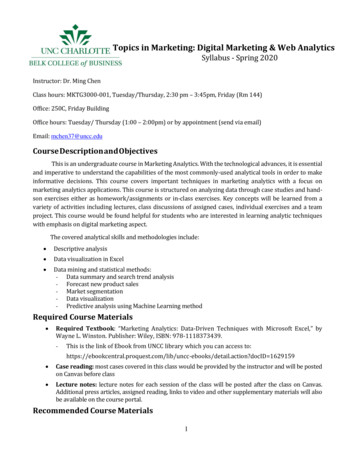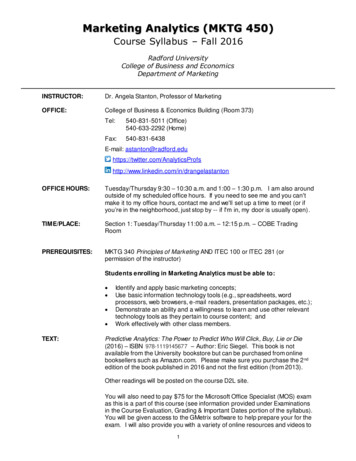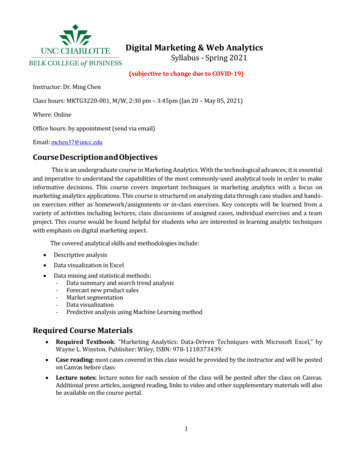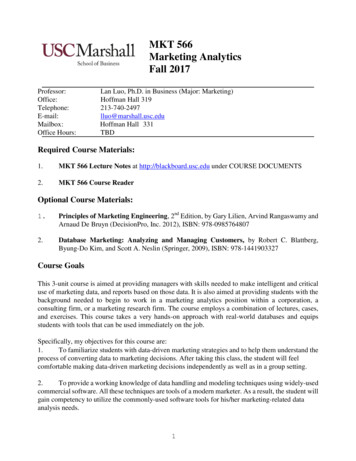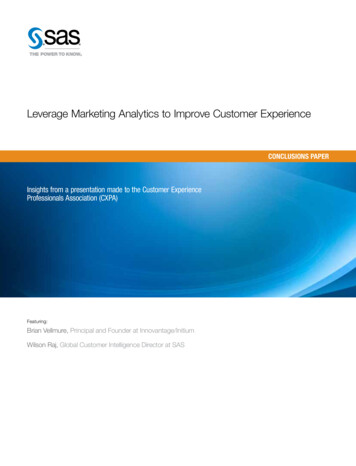
Transcription
Introduction toMarketing Analytics
Introduction to Marketing AnalyticsOutline The new realities of marketing decisionmaking Marketing Engineering (ME) The role of models in ME Allegro exercise
Introduction to Marketing AnalyticsChallenges faced by today’smarketing decision makers Global, hypercompetitive business environment.More demanding customers served by a greater numberof competitors on a global scale. Exploding volume of data“We’re drowning in data. What we lack are true insights.” Need for faster decision makingInformation overload and lack of time, yet decisions haveto be made all the time. Higher standards of accountabilityMarketing expenditures have to be justified in the sameway as other investments.
Introduction to Marketing AnalyticsNeed for better marketingdecision making Intuitive decision making Instinct, gut feelings, past experience, establishedpractices;In a world characterized by rapid change, informationoverload, greater accountability, etc. intuition isunlikely to generate superior results; Data-based and model-supported decision making Marketing Engineering
Introduction to Marketing AnalyticsMarketing Engineering (ME)“a systematic approach to harness data andknowledge to drive effective marketing decisionmaking and implementation through a technologyenabled and model-supported interactive decisionprocess.” (LRB, p. 2).
Introduction to Marketing AnalyticsSkills needed for Marketing Engineering
Introduction to Marketing AnalyticsMarketing EngineeringMarketing ghtsDecisionsImplementationAutomatic scanning, data entry,subjective interpretationDatabase management, e.g.,selection, sorting, summarization,report generationMental models,Decision modelsJudgment under uncertainty,e.g., modeling, communication,introspectionFinancial, human, and otherorganizational resources
Introduction to Marketing AnalyticsModels are the core of ME:What is a Model? Models are stylized representations of reality thatstructure our thinking about how the world works; Models indicate which factors should be consideredand which factors can be ignored; By focusing on the relevant factors and theirinterrelationship reality can be simplified; Models are useful because they facilitate top-downprocessing (as opposed to bottom-up processing);
Introduction to Marketing AnalyticsIssues in using models assembling an arsenal of models for a domain ofinterest; retrieving relevant mental models in a given situation; being aware of the limitations of mental models (theymay overrepresent and underrepresent, or evenmalrepresent, things);“No model is true, but some models are useful.”
Introduction to Marketing AnalyticsTypes of modelsVerbal“Sales are afunction ofadvertising”Box and ArrowGraphicalMathematicalsalesS a bA eAdvertisingSalesadvertising
Introduction to Marketing AnalyticsResponse models in the decision loopMarketing actions(inputs)Product design,Price, Advertising,Selling effort, etc.Competitive lesResponseModelEnvironmentalConditionsControl, AdaptationObjectivesEvaluation
Introduction to Marketing AnalyticsA simple (linear) response modelSales as a function of advertising 00000900000100000011000001200000Advertising spending130000014000001500000
Introduction to Marketing AnalyticsA simple (linear) response modelActual and predicted sales as a function of advertising 00000900000100000011000001200000Advertising spendingPredicted salesActual sales130000014000001500000
Introduction to Marketing AnalyticsA simple (linear) response modelSUMMARY OUTPUTRegression StatisticsMultiple R0.95R Square0.90Adjusted R Square0.88Standard dvertisingStandard Errort StatSignificance er 95%Upper 95%9231139.1 10581955.51.52.7
Introduction to Marketing AnalyticsHow to build a model Specify the model Variables (which ones to include) Relationships, interactions, dynamics (how they are linked) Calibrate the model Statistical estimation with real (historical) data Experimentation Managerial judgments Validate the model Face validity (does it make sense?) Global fit (R², model fit) Variable significance (correct signs, t-tests) Apply the model Ease of use Usefulness
Introduction to Marketing AnalyticsAllegroResource allocation "smart sheet" exerciseIntroductionFollowing are two business plan spreadsheets for the same company, Allegro. You have just been assigned tobe the brand manager and must formulate a plan for next year. As you will see, the projected profits for 2006 arehigher than the plan for 2007. To make a good impression, you need to develop a plan that will deliver higherprofits in 2007. Your job is to use each spreadsheet to determine the optimal level of price, advertising, andselling.How to use this spreadsheetStart with the Simple spreadsheet. It is a traditional spreadsheet. Use this as an aid to help you think aboutoptimal spending levels, and how this might affect market shares and net profits.Go to the second spreadsheet. It is a "smart" spreadsheet where projected market share is a function of price,advertising and distribution spending. If you change the planned price, sales (and contribution margin) willchange.Not surprisingly, as you lower price, volume increases, but the contribution margin decreases. As you increaseadvertising or selling effort sales volume increases. These response functions came from managerial judgment,but could just as easily come from statistical analysis of past data.Assume these estimates are reasonably good; however, change them if you think it is a good idea.Bright yellow indicates a cell you should change.Faded yellow indicates a cell you are allowed to modify. Do this only if you have good reasons todo so.
Introduction to Marketing AnalyticsThe Allegro exercise: Simple sheetAllegro Market Simple SheetIndustry Sales, in UnitsCompany Market SharePrice per UnitVariable Cost per UnitGross Margin per UnitSales Volume in UnitsSales RevenueGross Contribution MarginOverheadNet Contribution MarginAdvertisingSales Force and DistributionMarketing ResearchNet ProfitThis year(current)2,200,0003.0% 250 150 10066,000 16,500,000 6,600,000 3,500,000 3,100,000 900,000 1,000,000 100,000 1,100,000Next year(projected)2,345,7003.0% 250 150 10069,678 17,419,532 6,967,813 3,900,000 3,067,813 900,000 1,000,000 100,000 1,067,813This year(current)Next year(projected)Marketing Mix DecisionsPrice per UnitAdvertisingSales Force and Distribution 250 900,000 1,000,000 250 900,000 1,000,000
Introduction to Marketing AnalyticsThe profit equationProfit Revenues Sales Volume PriceIndustry sales Market ShareCostsVariable CostsFixed Costs
Introduction to Marketing AnalyticsQuestions Using the Simple Sheet, what happens when Allegro cutsadvertising and selling effort to 0 and raises price to 500/unit? Comment. Repeat exercise 1 using the Smart Sheet. Using the Smart Sheet, what is the profit maximizing level ofadvertising, selling effort and price? (Hint: Requires Solver)Would you recommend the firm implement this policy? Why orwhy not? What if the firm's goal was not to maximize profit, but tomaximize market share while maintaining profit at no lowerthan last year's level. (Hint: Requires Solver—and be sure tostart with a feasible level of profit). Compare this policy to theone you found in the previous question. Comment on the strengths and limitations of a responsefunction approach (Smart sheet) like this in practice.
Introduction to Marketing AnalyticsThe Allegro exercise: Simple sheet (Q1)Allegro Market Simple SheetThis year(current)Industry Sales, in UnitsCompany Market SharePrice per UnitVariable Cost per UnitGross Margin per UnitSales Volume in UnitsSales RevenueGross Contribution MarginOverheadNet Contribution MarginAdvertisingSales Force and DistributionMarketing ResearchNet ProfitMarketing Mix Decisions2,200,0003.0% 250 150 10066,000 16,500,000 6,600,000 3,500,000 3,100,000 900,000 1,000,000 100,000 1,100,000This year(current)Price per UnitAdvertisingSales Force and Distribution 250 900,000 1,000,000Next year(projected)2,345,7003.0% 500 150 35069,678 34,839,064 24,387,345 3,900,000 20,487,345 0 0 100,000 20,387,345Next year(projected) 500 0 0abcde c - df a x bg c x fh e x fij h - iklmn j - k - l - m
Introduction to Marketing AnalyticsQuestions Using the Simple Sheet, what happens when Allegro cutsadvertising and selling effort to 0 and raises price to 500/unit? Comment. Repeat exercise 1 using the Smart Sheet. Using the Smart Sheet, what is the profit maximizing level ofadvertising, selling effort and price? (Hint: Requires Solver)Would you recommend the firm implement this policy? Why orwhy not? What if the firm's goal was not to maximize profit, but tomaximize market share while maintaining profit at no lowerthan last year's level. (Hint: Requires Solver—and be sure tostart with a feasible level of profit). Compare this policy to theone you found in the previous question. Comment on the strengths and limitations of a responsefunction approach (Smart sheet) like this in practice.
Introduction to Marketing AnalyticsThe Allegro exercise: Smart sheet (Q2)Allegro Market Smart SheetThis yearThis yearWhat increase in sales will we see with a.1% decrease in price?.1% increase in advertising?.1% increase in sales effort?Next year2,200,0003.0% 250 150 10066,000 16,500,000 6,600,000 3,500,000 3,100,000 900,000 1,000,000 100,000 1,100,000Industry Sales, in UnitsCompany Market SharePrice per UnitVariable Cost per UnitGross Margin per UnitSales Volume in UnitsSales RevenueGross Contribution MarginOverheadNet Contribution MarginAdvertisingSales Force and DistributionMarketing ResearchNet ProfitMarketing Mix DecisionsPrice per UnitAdvertisingSales Force and DistributionManagerial Judgmental Inputs(current)(current) 250 900,000 1,000,000(projected)2,345,7000.0% 500 150 3500 0 0 3,900,000- 3,900,000 0 0 100,000- 4,000,000Next year(projected) 500 0 02.20%0.2%0.1%
Introduction to Marketing AnalyticsThe profit equationProfit RevenuesSales Volume Price CostsVariable CostsFixed Costs(Advertising, Distribution)(Other Fixed Costs)Industry sales Market Share
Introduction to Marketing AnalyticsQuestions Using the Simple Sheet, what happens when Allegro cutsadvertising and selling effort to 0 and raises price to 500/unit? Comment. Repeat exercise 1 using the Smart Sheet. Trial and error using the Smart Sheet. Using the Smart Sheet, what is the profit maximizing level ofadvertising, selling effort and price? (Hint: Requires Solver)Would you recommend the firm implement this policy? Why orwhy not? What if the firm's goal was not to maximize profit, but tomaximize market share while maintaining profit at no lowerthan last year's level. (Hint: Requires Solver—and be sure tostart with a feasible level of profit). Compare this policy to theone you found in the previous question. Comment on the strengths and limitations of a responsefunction approach (Smart sheet) like this in practice.
Introduction to Marketing AnalyticsQuestions Using the Simple Sheet, what happens when Allegro cutsadvertising and selling effort to 0 and raises price to 500/unit? Comment. Repeat exercise 1 using the Smart Sheet. Using the Smart Sheet, what is the profit maximizing level ofadvertising, selling effort and price? (Hint: Requires Solver)Would you recommend the firm implement this policy? Why orwhy not? What if the firm's goal was not to maximize profit, but tomaximize market share while maintaining profit at no lowerthan last year's level. (Hint: Requires Solver—and be sure tostart with a feasible level of profit). Compare this policy to theone you found in the previous question. Comment on the strengths and limitations of a responsefunction approach (Smart sheet) like this in practice.
Introduction to Marketing AnalyticsUsing Solver for Optimization
Introduction to Marketing AnalyticsThe Allegro exercise: Smart sheet (Q3)Allegro Market Smart SheetIndustry Sales, in UnitsCompany Market SharePrice per UnitVariable Cost per UnitGross Margin per UnitSales Volume in UnitsSales RevenueGross Contribution MarginOverheadNet Contribution MarginAdvertisingSales Force and DistributionMarketing ResearchNet ProfitThis year(current)2,200,0003.0% 250 150 10066,000 16,500,000 6,600,000 3,500,000 3,100,000 900,000 1,000,000 100,000 1,100,000Next year(projected)2,345,700 a2.7% b 275 c 150 d 125 e c - d63,571 f a x b 17,481,989 g c x f 7,946,358 h e x f 3,900,000 i 4,046,358 j h - i 1,589,271 k 1,033,026 l 100,000 m 1,324,061 n j - k - l - mThis year(current) 250 900,000 1,000,000Next year(projected) 275 1,589,271 1,033,026Marketing Mix DecisionsPrice per UnitAdvertisingSales Force and Distribution
Introduction to Marketing AnalyticsQuestions Using the Simple Sheet, what happens when Allegro cutsadvertising and selling effort to 0 and raises price to 500/unit? Comment. Repeat exercise 1 using the Smart Sheet. Using the Smart Sheet, what is the profit maximizing level ofadvertising, selling effort and price? (Hint: Requires Solver)Would you recommend the firm implement this policy? Why orwhy not? What if the firm's goal was not to maximize profit, but tomaximize market share while maintaining profit at no lowerthan last year's level. (Hint: Requires Solver—and be sure tostart with a feasible level of profit). Compare this policy to theone you found in the previous question. Comment on the strengths and limitations of a responsefunction approach (Smart sheet) like this in practice.
Introduction to Marketing AnalyticsThe Allegro exercise: Smart sheet (Q4)Allegro Market Smart SheetThis year(current)Next year(projected)Industry Sales, in Units2,200,0002,345,700Company Market SharePrice per UnitVariable Cost per Unit3.0% 250 1503.8% 244 150Gross Margin per Unit 100 94Sales Volume in UnitsSales Revenue66,000 16,500,00088,467 21,611,347Gross Contribution Margin 6,600,000 8,341,344OverheadNet Contribution MarginAdvertisingSales Force and Distribution 3,500,000 3,100,000 900,000 1,000,000 3,900,000 4,441,344 1,964,533 1,276,811Marketing ResearchNet ProfitMarketing Mix Decisions 100,000 1,100,000 100,000 1,100,000This yearPrice per UnitAdvertisingSales Force and Distribution(current)Next year 250 900,000 1,000,000(projected) 244 1,964,533 1,276,811
Introduction to Marketing AnalyticsQuestions Using the Simple Sheet, what happens when Allegro cutsadvertising and selling effort to 0 and raises price to 500/unit? Comment. Repeat exercise 1 using the Smart Sheet. Using the Smart Sheet, what is the profit maximizing level ofadvertising, selling effort and price? (Hint: Requires Solver)Would you recommend the firm implement this policy? Why orwhy not? What if the firm's goal was not to maximize profit, but tomaximize market share while maintaining profit at no lowerthan last year's level. (Hint: Requires Solver—and be sure tostart with a feasible level of profit). Compare this policy to theone you found in the previous question. Comment on the strengths and limitations of a responsefunction approach (Smart sheet) like this in practice.
Introduction to Marketing AnalyticsAssignment for next class Read LRB Chapter 3 Download Segmentation.pptx or Segmentation.pdf Read the Segmentation Tutorial (Enginius)
Introduction to Marketing Analytics Marketing Engineering (ME) “a systematic approach to harness data and knowledge to drive effective marketing decision making and implementation through a technology-enabled and mo
